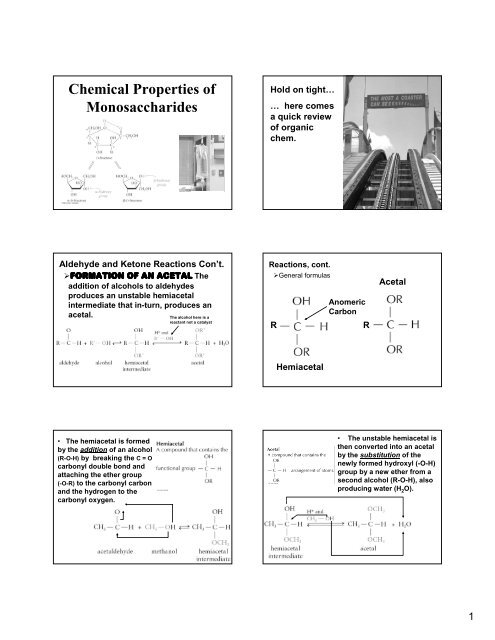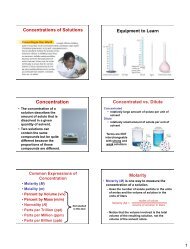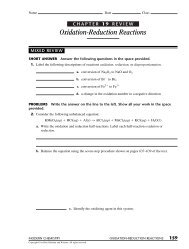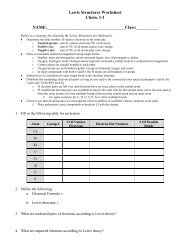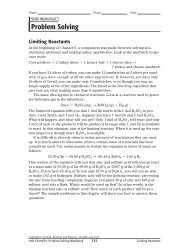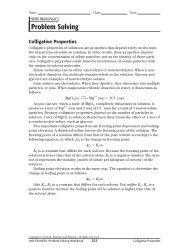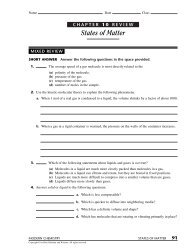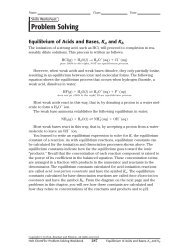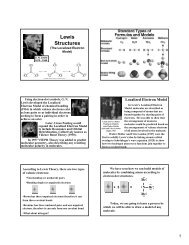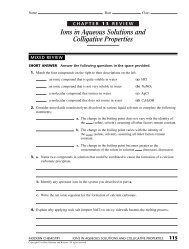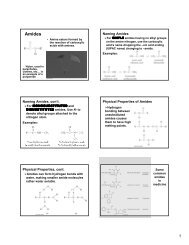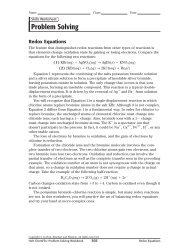L3 - Chemical Properties of Monosaccharide
L3 - Chemical Properties of Monosaccharide
L3 - Chemical Properties of Monosaccharide
Create successful ePaper yourself
Turn your PDF publications into a flip-book with our unique Google optimized e-Paper software.
<strong>Chemical</strong> <strong>Properties</strong> <strong>of</strong><br />
<strong>Monosaccharide</strong>s<br />
Hold on tight…<br />
… here comes<br />
a quick review<br />
<strong>of</strong> organic<br />
chem.<br />
Aldehyde and Ketone Reactions Con’t.<br />
Formation <strong>of</strong> an Acetal The<br />
addition <strong>of</strong> alcohols to aldehydes<br />
produces an unstable hemiacetal<br />
intermediate that in-turn, produces an<br />
acetal.<br />
The alcohol here is a<br />
reactant not a catalyst<br />
Reactions, cont.<br />
General formulas<br />
R<br />
Anomeric<br />
Carbon<br />
R<br />
Acetal<br />
Hemiacetal<br />
• The hemiacetal is formed<br />
by the addition <strong>of</strong> an alcohol<br />
(R-O-H) by breaking the C = O<br />
carbonyl double bond and<br />
attaching the ether group<br />
(-O-R) to the carbonyl carbon<br />
and the hydrogen to the<br />
carbonyl oxygen.<br />
• The unstable hemiacetal is<br />
then converted into an acetal<br />
by the substitution <strong>of</strong> the<br />
newly formed hydroxyl (-O-H)<br />
group by a new ether from a<br />
second alcohol (R-O-H), also<br />
producing water (H 2 O).<br />
1
Reactions Con’t.<br />
Formation <strong>of</strong> a<br />
Ketal The addition <strong>of</strong><br />
alcohols to ketones<br />
produces an unstable<br />
hemiketal intermediate<br />
that in-turn, produces an<br />
ketal.<br />
The alcohol here is a<br />
reactant not a catalyst<br />
• The hemiketal is formed<br />
by the addition <strong>of</strong> an alcohol<br />
(R-O-H) by breaking the C = O<br />
carbonyl double bond and<br />
attaching the ether group<br />
(-O-R) to the carbonyl carbon<br />
and the hydrogen to the<br />
carbonyl oxygen.<br />
• The unstable hemiketal is<br />
then converted into a ketal by<br />
the substitution <strong>of</strong> the newly<br />
formed hydroxyl (-O-H) group<br />
by a new ether from a second<br />
alcohol (R-O-H), also<br />
producing water (H 2 O).<br />
Even though hemiacetals and<br />
hemiketals are relatively unstable,<br />
cyclical hemiacetals and hemiketals are<br />
commonly found because they are more<br />
stable than open chains.<br />
Cyclic Structures <strong>of</strong> <strong>Monosaccharide</strong>s<br />
All monosaccharides with at least five carbon<br />
atoms exist predominantly as cyclic<br />
hemiacetals and hemiketals.<br />
A Haworth structure can be used to depict<br />
the α and β anomers <strong>of</strong> a monosaccharide.<br />
Anomers are stereoisomers that differ in the<br />
3-D arrangement <strong>of</strong> groups at the anomeric<br />
carbon <strong>of</strong> an acetal, ketal, hemiacetal, or<br />
hemiketal group.<br />
• Sixmembered<br />
pyranose<br />
ring system<br />
2
• When the newly formed hydroxyl group forms<br />
below the ring structure, it is said to form the<br />
alpha anomer and when it forms above the ring<br />
structure, it is said to form the beta anomer.<br />
• Six-membered pyranose ring system<br />
• Anomers are sugars that differ in stereochemistry<br />
only at the hemiacetal or hemiketal carbon.<br />
Five-membered furanose ring system<br />
Naming Cyclic <strong>Monosaccharide</strong>s<br />
• Designate the anomeric form <strong>of</strong> the cyclic<br />
sugar structure by preceding the<br />
monosaccharide name with α or β<br />
Classic Naming <strong>of</strong> Cyclic <strong>Monosaccharide</strong>s<br />
• Identify as 5 carbon ring (furanose) or 6<br />
carbon ring (pyranose)<br />
β-D-glucopyranose<br />
α-D-glucopyranose<br />
• Drop the –se from the straight chained<br />
monosaccharide name and replace with<br />
furanose or pyranose<br />
• Designate the anomeric form by preceding<br />
the entire name with α or β<br />
α-D-fruct<strong>of</strong>uranose<br />
β-D-fructopyranose<br />
3
Drawing Haworth Projections<br />
• We have been representing cyclic<br />
monosaccharides using Haworth Projections,<br />
a standardized way <strong>of</strong> representing<br />
carbohydrate stereoisomerism in 3D space.<br />
• Haworth projections are drawn directly from<br />
Fischer Projections simply by following the<br />
steps below.<br />
1. Draw the correct Fischer projection for the<br />
monosaccharide.<br />
• Note, the α or β is not determined by D<br />
or L.<br />
Drawing Haworth Projections<br />
2. Draw a primary pyranose or furanose ring<br />
structure depending on the<br />
monosaccharide.<br />
3. Number the ring structure beginning with<br />
the carbon directly right <strong>of</strong> the oxygen atom<br />
in the ring (begin with the anomeric<br />
carbon).<br />
• Remember, the last carbon is above the<br />
ring.<br />
Drawing Haworth Projections<br />
4. Assign hydroxyl group and hydrogens<br />
to all carbons other than the anomeric<br />
carbon following the following rule:<br />
Hydroxyl groups pointing to the left in the<br />
fissure projection are position upward on<br />
the Haworth Projection and those hydroxyl<br />
groups pointing to the right are positioned<br />
downward.<br />
1.Try drawing the Haworth Projections for<br />
the following monosaccharides:<br />
β-D-mannopyranose<br />
α-D-xyl<strong>of</strong>uranose<br />
β-L-galactopyranose<br />
5. Assign the acetal carbon a hydroxyl<br />
group corresponding to its anomeric<br />
designation (β up, α down)<br />
Remember Benedict’s Test?<br />
In the presence <strong>of</strong> aldehydes, Benedict’s<br />
reagent (containing CuSO 4 ) produces a red<br />
copper precipitate.<br />
Benedict’s<br />
reagent in<br />
comparison<br />
to 2 glucose<br />
solutions<br />
<strong>Monosaccharide</strong> Reactions<br />
Oxidation <strong>of</strong> a Reducing Sugar<br />
The oxidation <strong>of</strong> a carbonyl group on a<br />
monosaccharide.<br />
•Since all monosaccharides are in equilibrium<br />
with their cyclic form, they are all reducing<br />
sugars.<br />
•Benedict’s reagent is commonly used to test for<br />
the presence <strong>of</strong> reducing sugars:<br />
Reducing sugar + Cu 2+ → oxidized compound + Cu 2<br />
O<br />
blue<br />
orange-red<br />
precipitate<br />
4
<strong>Monosaccharide</strong> Reactions, cont.<br />
Esterfication The –OH groups <strong>of</strong><br />
monosaccharides can behave as<br />
alcohols and react with acids (especially<br />
phosphoric acid) to form esters.<br />
<strong>Monosaccharide</strong> Reactions, cont.<br />
Glycoside Formation Cyclic<br />
monosaccharide hemiacetals and<br />
hemiketals react with alcohols to form<br />
acetals and ketals, referred to as<br />
glycosides.<br />
This is an important reaction<br />
in the formation <strong>of</strong> Lipids<br />
studied in the next chapter<br />
• The unstable hemiacetal is<br />
then converted into an acetal<br />
by the substitution <strong>of</strong> the<br />
newly formed hydroxyl (-O-H)<br />
group by a new ether from a<br />
second alcohol (R-O-H), also<br />
producing water (H 2 O).<br />
The dehydration <strong>of</strong> the hemiacetal or<br />
hemiketal forms what is called a<br />
glycosidic linkage.<br />
A glycosidic linkage is an ether link<br />
between a carbohydrate (poly hydroxyl,<br />
or glycol compound) and another carbon<br />
molecule.<br />
5


